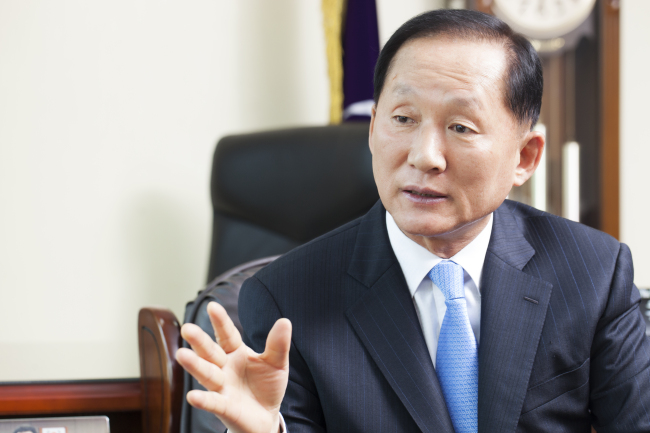[Herald Interview] Breaking stigma against 2-year vocational college
KCCE chairman talks on the need to reevaluate of labor and education in Korea
By Jo He-rimPublished : March 22, 2018 - 18:35
South Korea is well-known for its society’s great fervor toward education, but activists say that the country must break away from its relentless focus on credentials.
More than 98 percent of the teenage population graduates from high school, and in 2017, 68.9 percent of those in the 18 to 21 age group advanced to college, according to the Education Ministry. The figures are among the highest in the OECD.
More than 98 percent of the teenage population graduates from high school, and in 2017, 68.9 percent of those in the 18 to 21 age group advanced to college, according to the Education Ministry. The figures are among the highest in the OECD.

However, this fervor for education has given rise to credentialism, creating a society heavily dependent on the name value of universities in assessing an individual’s qualifications. Academic inflation has effectively devalued actual experience on the job and undermined diplomas earned from all but the most prestigious institutes.
Lee Ki-woo, the president of the Korean Council for University College Education -- a group that advocates for two-year vocational colleges -- urged the society to break away from credentialism and promote competency-based education.
“Instead of valuing the name of the university one graduated from, the perception should change to prioritize the competence of an individual,” Lee said during an interview with The Korea Herald.
Lee, who is also the chairman for Incheon JEI College, a vocational school, said his goal has remained the same since he started to lead the institute 12 years ago -- to change the social stigma against vocational colleges.
The vocational schools are often run with two-year curriculums, and are also referred to as junior or community colleges in other countries.
Although such schools are very much skill-oriented and give students a lot of practical experience, their graduates do not go on to hold jobs respected in society such as lawyers and doctors.
“Though vocational schools offer education on practical skills and abilities, they were still perceived as institutes for those who did not study enough to make it to a university. There were many dropouts who would quit to reapply to four-year institutions.” Lee said. “Even the government had looked down on the voices from vocational schools.”
The first vocational college opened in 1979, and there are now 137 of them nationwide – making up 40 percent of tertiary education institutes. There are 201 universities.
But the enduring belief that a degree from a prestigious university guarantees a “successful” life is slowly fading, Lee said. More people are realizing their interests and abilities are more important than the names of the schools and majors.
“The change is very slow, but I can actually feel it. There are more students who voluntarily come to learn the specific skills,” Lee said, highlighting that the number of university graduates reentering junior colleges was increasing.
According to KCCE data, the number of four-year institute graduates applying to junior colleges is on the rise, from 4,800 in 2013 to 7,412 in 2017.
“The current trend would be unimaginable in past years. More people are learning to pursue jobs that they really want.”
The government also appears to see the social issues stemming from academic inflation, such as the high unemployment rate, Lee said.
In 2013, the government created National Competency Standards that enables industries and schools to accurately evaluate one’s competence, and now they have the tests on over 900 different jobs.
This year, the Education Ministry was restructured on Jan. 1. The ministry changed the name of its University Policy Department to Higher Education Policy Department and subdivided the sectors to look more closely into vocational education.
Lee still viewed more changes should be pushed by the government and that it needs to provide more support for vocational schools.
“Vocational schools have contributed much to lower the youth unemployment rate, but their support has always fell far behind the four-year institutes,” Lee said. “About 35 percent of the students are from vocational schools, and a big portion of the students are from low-income families.”
Lee believes that the changes in perspective toward education and labor will reduce the pay gap between blue- and white-collar workers and the discrimination against those that are not “office workers.”
In the statistics released by the Ministry of Employment and Labor last year, an hourly wage for a four-year university was 21,140 won ($19.70) while it dropped to 15,364 won for two-year college graduates in 2016.
One who has devoted his career in education since he started working for a provincial Education Ministry in 1967, Lee said the core of education should be to ignite passion in the minds of the students.
“It is crucial that students are able to choose their majors upon their interest so that they can continue to pursue improvement in the field, rather than relying on the brand of the university,” he said, pointing to how credential-driven students may be less engaged than those who are learning for personal enrichment.
“Raising self-regard and confidence in the students is the most important part of education. Allowing each of them to truly believe and find joy in their achievements is very important,” he said.
Lee also wished vocational schools would become a place where people of all ages reach out to learn for their personal enrichment to foster various skills in life.
By Jo He-rim (herim@heraldcorp.com)












![[Today’s K-pop] BTS pop-up event to come to Seoul](http://res.heraldm.com/phpwas/restmb_idxmake.php?idx=644&simg=/content/image/2024/04/17/20240417050734_0.jpg&u=)





![[KH Explains] Hyundai's full hybrid edge to pay off amid slow transition to pure EVs](http://res.heraldm.com/phpwas/restmb_idxmake.php?idx=652&simg=/content/image/2024/04/18/20240418050645_0.jpg&u=20240418181020)

![[Today’s K-pop] Zico drops snippet of collaboration with Jennie](http://res.heraldm.com/phpwas/restmb_idxmake.php?idx=642&simg=/content/image/2024/04/18/20240418050702_0.jpg&u=)